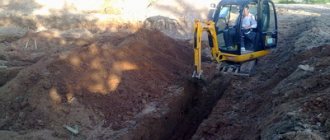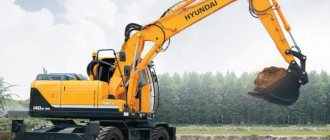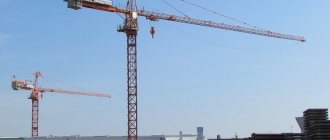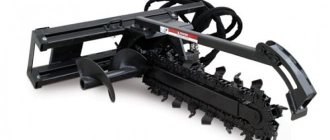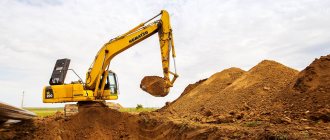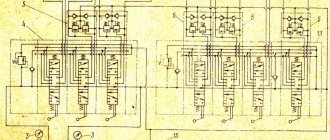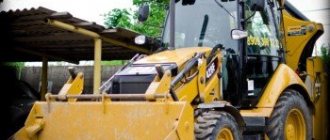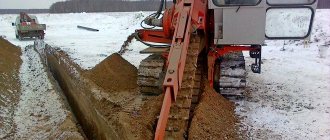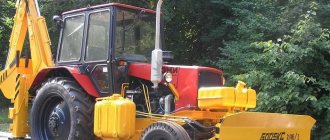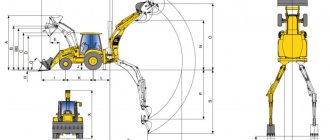Digging trenches for the foundation with an excavator is often an indispensable solution for large construction projects.
To competently complete this task, you need to take into account a lot of nuances. Which earthmoving machine to choose for a strip foundation, how much it will cost to dig trenches, what problems and errors will arise during the excavation process - all these questions need to be clarified at the design stage.
When is digging with machinery needed?
When arranging strip foundations for suburban buildings, trench digging is usually done manually and mechanically. The first option is economically beneficial if the future house is small, the foundation is shallow, the soil is easy to dig, and weather conditions allow the construction work to be extended. In other cases, the help of special equipment will be required.
For example, in winter it is necessary to prevent rapid freezing of the soil during the process of digging and pouring the foundation. If the bottom or walls of the trench are quickly set by frost, this will affect the stability of the building, which is undesirable.
You also need to hire an excavator operator if:
The soil is very dense and difficult to dig by hand, and contains large rocky inclusions (more than 30 cm in diameter).- The volume of excavation work is very large - tons of soil will need to be transported outside the site.
- It was a rainy summer. The weather factor is very important, since when exposed to precipitation, the soil changes its bearing capacity. To eliminate this drawback, it will be necessary to remove the entire wet layer of soil from the bottom of the trench to a dry base, which will lead to an increase in the cost of construction work on arranging the sand cushion.
Economic calculations show that with a large volume of excavation work, it is much cheaper to pay for the work of special equipment than for one team of workers.
There are cases when excavator operation is impossible. For example, it is impossible to provide access to a site for special equipment without destroying existing communications and disturbing the terrain of the site. In this case, there is nothing left to do but use the service of workers to dig trenches.
If the groundwater level is high, a monolithic foundation is installed with the construction of a pit. This option is also relevant if the owner of the future home wants to make a basement or basement. Here you will also need to use special equipment, but for digging a pit. Of course, the cost of such work will be much more expensive than a conventional strip foundation.
Types of machines for developing trenches for foundations and selection features
Several types of machines are used for trenching work
Single-bucket machines with flexible or rigid suspension, front or backhoe.- Excavators with dragline or grab.
- Continuous machines - multi-bucket (chain and rotary), bucketless (rotary), scraper (chain).
- Wheeled, mounted or tracked excavators.
The choice of one or another type of special vehicle depends on the type of soil, volume of work and hydrogeological conditions on the site.
In suburban construction, single-bucket mechanisms with a bucket capacity of 0.15 to 4 cubic meters are used. The larger the volume of soil an excavator can move, the larger the area it occupies on the site and the more its rental will cost.
Principles for choosing a machine depending on the type of soil:
- On dense, durable soils, pneumatic wheeled machines can be used.
- On loose, loose soils and hard rocks, it is advisable to use tracked mechanisms.
- In off-road conditions, wheeled tractors with attachments are used.
Also, special equipment is selected depending on the tasks:
- When digging foundations up to 7 m deep, mechanisms with a backhoe are used. They are convenient because they allow you to develop trenches below the parking level.
- Dragline excavators are often used for mining and digging in high groundwater conditions. They have a greater range of action compared to conventional mechanisms and dig to a depth of 16-20 m.
- To organize high-precision excavation work, mechanisms with a scraper knife mounted on a bucket are used. This option is appropriate if the owner of the site wants to clean the bottom of the trench after digging mechanically rather than manually. With this method, there is no need for manual modifications to the machine.
- Multi-bucket excavators are often used when digging trenches for pipelines and utility lines, the depth of which is limited.
Technical parameters of mining excavators
The technical characteristics of this type of quarry equipment directly affect the amount of work it can perform.
The most important parameter is the capacity of the bucket, which in some models can reach 50 cubic meters. The higher the value of this characteristic, the greater the volume of cargo the machine can move. The larger the boom (it can reach 55 meters in length), the higher the quarry walls can be.
In addition to the above, the excavator has the following parameters:
- the fastest models move at a speed of 2.5 km/h;
- the caterpillar width can be up to 24 meters;
- the working cycle lasts 50 seconds;
- the excavator presses on the ground with a force of up to 0.42 MPa;
- the radius of scooping and unloading is 24 meters;
- the unloading height can be 24 meters, and the digging height can be up to 21 meters;
- the maximum digging radius is 30 meters, and the clearing radius is 20.4 meters.
Parameters of ECG excavators
Preparing the site for digging
To prepare the area, perform the following steps:
- uproot all trees and stumps that interfere with construction;
- remove and transport stones;
- remove the top layer of turf.
It is important for an excavator operator to know where to store topsoil and soil for backfilling.
You also need to determine the location for removal of the bulk of the earth, which will subsequently not be needed on the site.
After this, if there are underground communications on the site, you need to open them using a pit and mark their location on the site, protect them with boxes with warning signs.
When marking the outer boundaries of the future building, you can use iron rods half a meter long with red flags on them for good visibility.
To ensure the passage of special equipment, the entire surface of the earth must be carefully planned in width and height. Existing uneven terrain is removed using a bulldozer, cutting off the excess height to 15 cm and moving it to a dump. In exactly the same way, plan the width of the excavator passage, marking the passage area equal to the width of the bulldozer passage in one direction.
When leveling the site, the soil is moved in the first gear of the machine, and returned to the face using reverse gear without turning the bulldozer.
After this, you need to carry out a geodetic breakdown of the location of the trench. That is, mark the territory and install temporary benchmarks (pegs or bars), which will serve as a starting point for measuring the correct depth of the trench.
Specialists must lay out a breakdown of the territory, mark the location of the trench, its depth and width. In this case, they are guided by SNiP 3.01.03-84 and SNiP 3.02.01-87.
Soil development technology for ditch digging
The width of the trench is made wider than the strip foundation for the convenience of workers. According to building codes, the “increase” in width must be at least 0.1 m on both sides, taking into account waterproofing and formwork.
When monitoring the operation of an excavator, they are guided by the requirements of SP 45.13330.2017
The process of developing soil with a trench excavator consists of a sequence of operations:
- Cutting the earth layer and filling the bucket;
- Lifting the load and turning the machine to the dump site;
- Unloading existing soil and returning to its original position.
The position of the excavator must be organized in such a way that as little energy as possible is spent on turning the machine to the loading site, saving fuel and time.
Slaughter options
The following development methods exist:
- Frontal (end) face.
- Side option.
- With a backhoe or using a dragline.
The face is the working area of an earthmoving machine . It includes an excavator parking lot and a mass of soil that is being developed. In this zone there are also additional means of mechanization - dump trucks or KAMAZ trucks for loading the earthen layer, if it is immediately removed from the work site.
Using a straight shovel, they dig the soil in a frontal or lateral manner, unloading it above the excavator parking lot. The end version is a method of excavating an earthen layer towards itself on both sides of the machine. This method is used for digging pits.
For trenches, a side slaughter option is used , in which the excavation of the soil occurs along one of the sides of the excavator, or using a backhoe. The second method involves excavating below the excavator's location.
a — frontal face b — side face
Features of the technology
Mechanized soil development should be carried out with minimal destruction of the soil, which will serve as the basis for the foundation. That is why the excavation of land is carried out with a “shortage”. This means that the excavator must dig a trench without reaching the marked bottom by 5-30 cm. The remaining soil at the bottom must be poured manually or using machines to the design mark before pouring the foundation.
Digging trenches should be carried out with dumps placed on one side only; building codes prohibit unloading soil from both sides of the trenches, except in cases where this is impossible due to cramped conditions on the site.
The most commonly used ditch digging machine is the backhoe type . For it, there are limits for “shortage” - up to 30 cm. If you choose a machine with a scraper mechanism, there is no need for “shortfall” of soil, since the digging error does not exceed 2 cm. When choosing a multi-bucket machine, the “shortfall” will be no more than 15 cm.
If the soil was unloaded below the design mark for pouring the foundation, then the existing layer of earth can be added to the bottom and compacted mechanically. If there are no means of mechanization, additional bedding in the form of sand, crushed stone or gravel is used.
If during the work the bottom of the trench under the foundation was soaked, it is drained by digging up to a dry layer. The work estimate includes additional costs for arranging a sand cushion.
When operating an excavator, it is recommended to unload soil at a distance of no less than 1 m from the upper boundary of the trench, outside the collapse prism.
To organize construction work on the site, they are guided by the rules of SNiP 12-04-2002 and fire safety rules.
Kopka in winter
For winter time, there are the following development methods:
- Back to ground. In advance, in the fall, before the onset of frost.
- Without preliminary preparation, that is, without loosening the frozen soil layer.
- With loosening using bulldozers and other means of mechanization.
With a soil freezing depth of up to 0.3 m, trenches can be dug using single-bucket excavators.
Rotary machines are used for large-scale mining - with a frozen layer thickness of up to 1.5 m . The freezing depth of the trench up to 1.3 m allows the use of mechanisms with a backhoe with a bucket capacity of more than 0.65 cubic meters of soil.
With preliminary loosening, the winter trenching technology provides for a depth of up to 0.4 m.
Types of Ditches
There are 3 types of foundation ditches:
- Vertical,
- With slopes,
- With reinforced walls.
When developing trenches, slopes of the side walls are planned according to the rules of SNiP III -8-76. The standards are shown in the table:
| Soil type | The ratio of the height of the slope to its width | ||
| With trench depth: | |||
| Up to 1.5 m | 1.5-3.0 m | 3.0-5.0 m | |
| Sand | 1:0,5 | 1:1 | 1:1 |
| Sandy loam | 1:0,225 | 1:0,67 | 1:0,85 |
| Loam | 1:0 | 1:0,5 | 1:075 |
| Clay | 1:0 | 1:0,25 | 1:05 |
| embankment | 1:0,67 | 1:1 | 1:1,25 |
| hard rock | 1:0,2 | 1:0,2 | 1:0,2 |
In conditions of limited area of the site, when it is impossible to lay slopes in the development of trenches, they are strengthened with the help of support posts - spacers. After excavation using special equipment, they are installed to prevent soil collapse.
Fastening the vertical walls of trenches at excavation depths of up to 3 m is carried out with boards in a vertical and horizontal manner on sandy soils. On clay, sandy loam and loam, they are fastened with horizontal boards. If the groundwater level is high, fastening is carried out using sheet piles.
Features of a mining excavator
The design of the excavator is conventionally divided into three areas (chassis, working and power) and includes the following elements:
Construction of a mining excavator
- ladle;
- body;
- arrow;
- rotating platform;
- handle;
- bottom frame;
- track frame;
- two-legged stance.
This design allows the machine to easily move over uneven surfaces and overcome obstacles without the risk of overturning. Some models can be additionally equipped with individual electric drives and have a control and safety system.
Pros and cons of using technology
The most convenient and fastest way to develop soil is to hire a trencher. It is suitable for digging narrow holes, not only for the foundation, but also for any utilities: laying pipelines, electrical networks and sewerage.
Advantages of using technology:
- fast labor productivity;
- high quality of work when choosing an excavator with attachments in the form of a soil cutter;
- ability to develop large volumes of soil.
Disadvantages of using the machine:
- high price for renting modern excavator models;
- destruction of the existing landscape for vehicle passage;
- the need to protect communications (pipelines from heavy equipment).
In cases where it is necessary to preserve the existing landscape and communications, it is better to use manual labor for digging trenches, mini-excavators.
Problems and errors
The most common mistake when building a house is postponing the foundation pouring date until next year.
Soaking trenches leads to erosion and heaving of the soil in winter, as a result of which it loses its load-bearing capacity.
Likewise, you should not wait for the next season after installing the strip foundation. Experts recommend that, if possible, all construction work be completed in one season along with the construction of the walls.
In the process of digging trenches, it is necessary to prevent the trenches or pit from getting wet, which is why all excavation work and pouring of the foundation is best done in dry weather, in a short time.
Next mistake: incorrect choice of trench type without taking into account the type of soil . If you do not take into account building codes, this will lead to soil collapse. In conditions of weak soils, the walls are strengthened with formwork or slopes are laid. The more friable the soil, the larger the slope should be laid.
When calculating the width of the trench, waterproofing should be taken into account. When laying it, expand the base of the trench by 0.5 m.
A common problem when digging is also non-compliance with safety regulations during construction. If the trench depth is more than 1.3 m, descending into it is allowed only after checking the slopes and reinforcements to avoid soil collapse.
It is better to erect the formwork for the base immediately after digging the trenches, so the risk of collapse will be minimized.
Calculation of trench dimensions
The trench dimensions are calculated in accordance with the requirements for laying the pipeline. So, with a pipe diameter of 1 meter and an excavation depth of 3 meters, the width of the trench will be about 2 meters (external diameter of the pipe + 1 meter), and in the case of an excavation depth of more than 3 meters, 20 cm is added to the width of the trench for each additional meter of depth .
When the trench is located below the base of the embankment, its profile can have a trapezoidal, rectangular or mixed shape, depending on the hydrogeological state of the area. In stable soil without excess moisture, it is possible to dig channels with vertical walls without securing them. The depth will directly depend on the established soil type:
- Bulk sandy, gravelly - maximum 1 meter.
- Sandy loam, loamy – up to 1.25 meters.
- Clayey – up to 1.5 meters.
When excavating soil to significant depths, it is worthwhile to ensure a trapezoidal wall profile. In any case, it is calculated at the design stage, taking into account all established engineering surveys.
